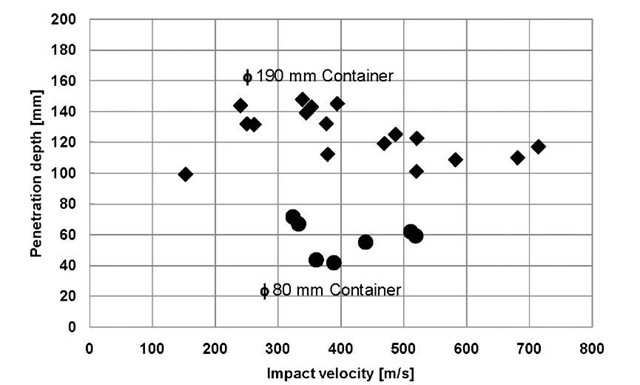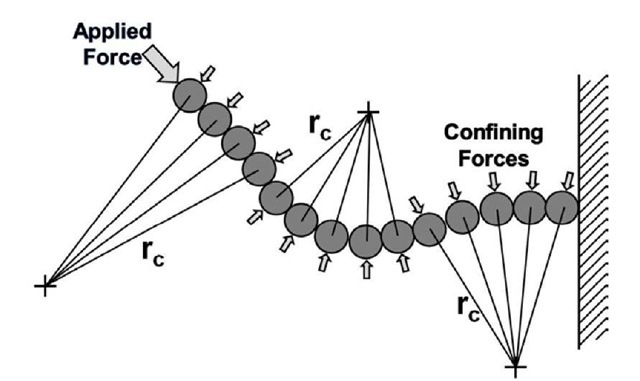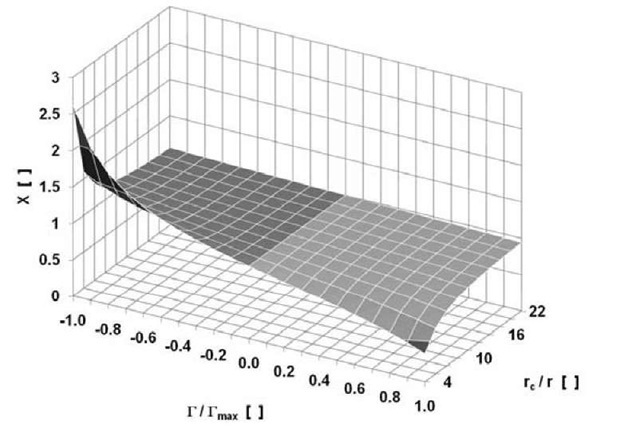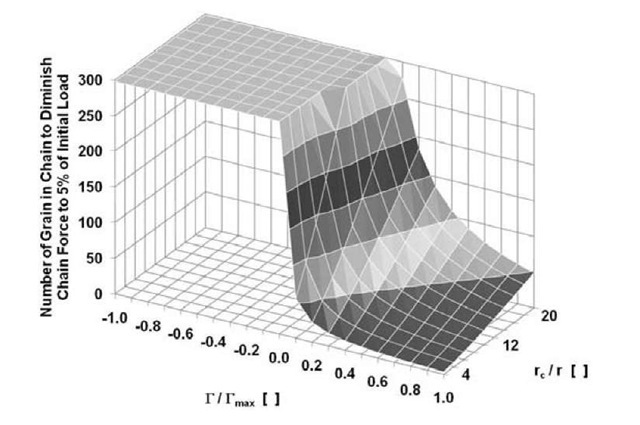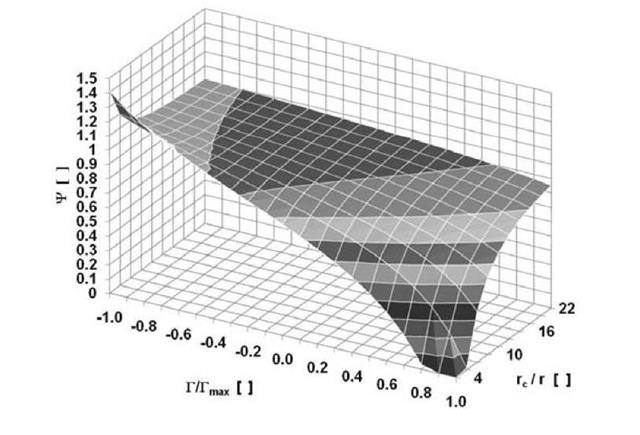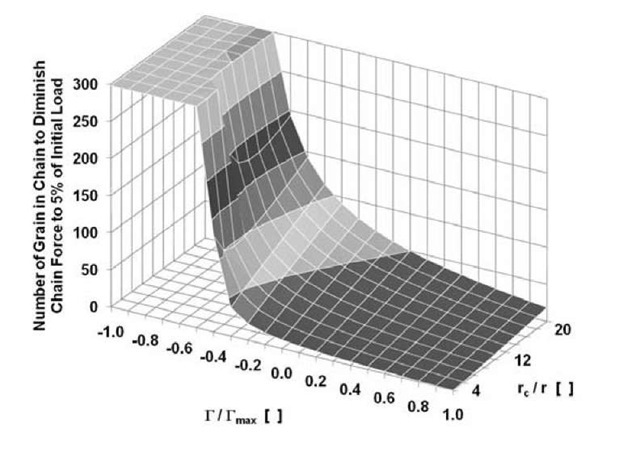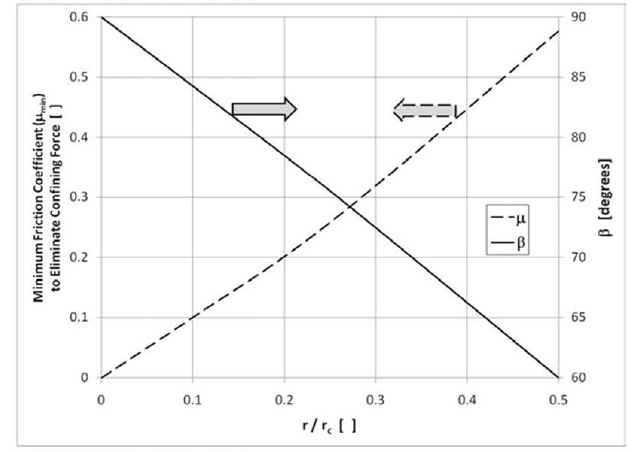ABSTRACT
Right-circular (^ 15 mm x 26 mm) projectiles were fired vertically-downward (150-720 m/s) into acrylic containers (^ 80-190 mm) containing quartz Eglin sand. Decreasing container size increased projectile drag and decreased total penetration depth. Thus, the container is within the projectile’s event horizon for at least a portion of penetration path length and some mechanism(s) exists for communication between projectile and container. The particulate media fractured near the projectile nose and created a rigid, conical false nose on the front face of the projectile, but the fractured media domain does not extend beyond 1.5 projectile diameters of the shot line. Jammed grains (i.e. mechanically-compacted, but not fractured) can be found adjacent to the fractured media; surrounded by nominally initial-density grains. It is theorized that the projectile communicates with the container via stress chains in the un-fractured grains which span the distance between the projectile/crushed media and container wall. The stress chain event horizon may be limited by either mechanical decay of forces along the chains or limited stress wave speeds in the particulate media. This paper focuses upon the mechanical force decay limits. Multiple analytical models are presented to illustrate how stress chain curvature and friction can limit the maximum stress chain length and thereby the ability of projectiles to communicate through the particulate media with the container wall.
INTRODUCTION
Researchers at Osaka University [Watanabe 2010] conducted experiments to observe the high-speed impact of right-circular cylinder projectiles (12.3 g, steel front face, polycarbonate body) with quartz Eglin sand (^ 75-1,400 |im grains, d50=400 |im, as-poured p=1.53 g/cc) [Cooper 2010]. Projectiles were launched vertically downward and impacted the sand surface normally (flat face parallel to sand) at 150-720 m/s. Projectile velocities were measured using induction loops and impact attitude was validated with high-speed photography. Two containers were used: ^ 80 mm & ^ 190 mm internal diameter, 300 mm length. Total penetration depth did not vary appreciably with impact velocity, but was strongly affected by the container size. Decreasing the container size from 190 mm to 80 mm cut the penetration depth in half as shown in Fig. 1. Thus, it can be inferred that the projectile communicates with the container–the stresses at the projectile surface and the drag on the projectile are affected by the container size. The goal of this analysis is to examine the mechanics that enable the projectile to communicate with the container.
Figure 1 Projectile penetration depth as function of impact velocity
High pressure directly ahead of and beside the projectile nose comminute and fracture the sand media, forming a rigid, conical false nose on the front of the projectile. They also comminute and fracture sand up to 1.5 projectile radii from the projectile centerline. The increased density of the comminuted sand can easily account for the sand volume displaced by the projectile. However, this region spans only a fraction of the sand container diameter and does not fully explain the communication between the projectile and container unless the container is on the order of 3 projectile diameters or less. Outside the comminuted sand region the sand can be mechanically-compacted, but does not fracture; suggesting a maximum density of 1.73 g.cc (the maximum mechanical compaction density achieved previously [Cooper 2010]) which decays with distance to the initial density of 1.53 g/cc.
2-D experimental work [Howell et al. 1999] and 2-D discrete element modeling (DEM) [Peters et al. 2005, Tordesillas et al. 2005] indicate that grain contact mechanics allow formation of stress chains which can propagate stress information over considerable distances. Howell et al. measured stresses in a 2-D Couette flow (inner radius 10.34 cm, outer radius 19.14 cm) using birefringent discs and showed that chains have a mean length of 2 to 5 particles, depending upon the particle packing fraction. Most chains are quite short with only a few percent of the chains exceeding 8 or 10 discs in length. However, visual inspection of experimental images shows chains which bridge the gap between inner and outer radius (roughly 100 discs in width) and much longer chains might be visually constructed because the chains form at angles to oppose rotation of the inner drive wheel. The authors note the difficulty in defining the length of chains. In this case the authors defined the chains "to be any set of nearly co-linear discs carrying stress larger than the mean." The chains end at branches (which are common) or boundaries. This definition is excellent for assessing the force structure in the particulate material fabric. However, it does not address the primary question of interest to the present effort; How far can chains of grains propagate stresses to facilitate communication between points or surfaces in a particulate media (PM)? This question requires assemblies of chains (as defined by Howell et al.) such that the stress at one end affects the stress at the other. Depending upon interactions with surrounding grains, chains can satisfy this question while loaded with stresses more or less than the mean. Such chains can split or re-combine to produce chain segments with more or less stress than the mean.
Peters et al. considers a quasi-static case more analogous to the present projectile impact—the impinging of a square punch upon the upper surface of a 2-D PM bed—and reports average chain lengths of approximately 5 grains with an exponential decay of the chain length PDF. In this case the definition of a chain is more specific than above—a "linear string of at least three rigid particles in point contact that can support loads along its axis, with only small amounts of rotation involved." [Peters 2005, Cates et al. 1998, 1999] Chains are allowed some maximum degree of curvature. Exceeding this value (e.g. ±45°) breaks the chains into shorter segments in a method similar to Howell’s branching criteria. The stress chains organize to oppose the motion of the punch and roughly 40% of the particles are more highly stressed than the average (the "strong network"). Of these stressed particles only half are involved in chains longer than 2 particles. Again, this chain length definition is effective for assessing the stress-carrying structure in the PM fabric, but does not specifically address the communication question. Consider the question of chain lengths if an international cell phone call is made. Each specific segment (cell phone to tower, fiber optic cable, satellite up/down-link, etc.) may have a specific length, but if connected end to end allows the termination points to communicate–affect each other. Fig. 10 in Peters et al. serves to both illustrate this point and to emphasize the far-from-equilibrium behavior that typifies particulate materials [NRC 2007]. Standalone force chains (greater than average stress) are observed in the middle of grain ensembles with less than average stress. This suggests that stress information is communicated through the region of low stress by multiple low-stress force chains which can converge to load a chain more highly than average, before branching again.
Thus a communications-focused chain length definition is needed: Communication chains are any ensemble of grains in contact for which stress changes at one location (chain end) affect the stress at another location (other end of chain). Such chains can incorporate multiple segments at higher/lower-than-average stress levels according to the definitions above. It is also possible, even likely, that stress changes at one grain may affect the stress levels in a variety of locations throughout the particulate material. This introduces the idea of ad hoc communication networks in particulate materials. The present effort focuses on a very narrow subset of the theory required to explain ad hoc communication networks in PM. Several analytical models are developed which help explain the stability of communication chains and to set bounds on their lengths based upon consideration of both the chains’ radius of curvature and friction (inner-chain and inter-chain).
ANALYTICAL MODELS
Given the communication chain definition, a model particulate chain can be constructed as shown in Fig. 2. The chain has both a beginning & end and all grains are in contact (point-wise for spherical grains considered here). Geometrically, any two neighboring grains have a characteristic radius (rc) of curvature. In practice the origin of each rc can vary wildly in three dimensions, but flattening this to 2-D provides a simpler illustration. Following the example of the projectile impacting the PM, the projectile applies a force to one end of the chain and it is theorized that communication with a confining wall can affect this force. In practice the experimental results indicate that the closer the wall, the larger the applied forces by/on the projectile, the higher the drag, and the shorter the total penetration length.
Figure 2 Theoretical particulate material communication chain model
Kinematically, the grains must be confined by some forces in order to maintain contact along the full chain length. These confining forces are provided by other grains in the PM as shown in Figs. 2 & 3. Fri is the confining force for the ith grain. Fi-1 and Fi are the inter-grain forces. Frsi, Fsi-1 and Fsi are the shearing (frictional) forces between grains. The angles ^ and p are defined as follows:![]() r is the angle of the confining force; which is limited by the presence of the i-1 and i+1 grains. Note that if r is negative then the confining force can amplify the Fi-i loading force such that the force can increase along the length of the chain. For all calculations r, rc, r and friction coefficient values (|) are assumed constant along the entire chain length, although they would vary in practice from grain to grain.
r is the angle of the confining force; which is limited by the presence of the i-1 and i+1 grains. Note that if r is negative then the confining force can amplify the Fi-i loading force such that the force can increase along the length of the chain. For all calculations r, rc, r and friction coefficient values (|) are assumed constant along the entire chain length, although they would vary in practice from grain to grain. 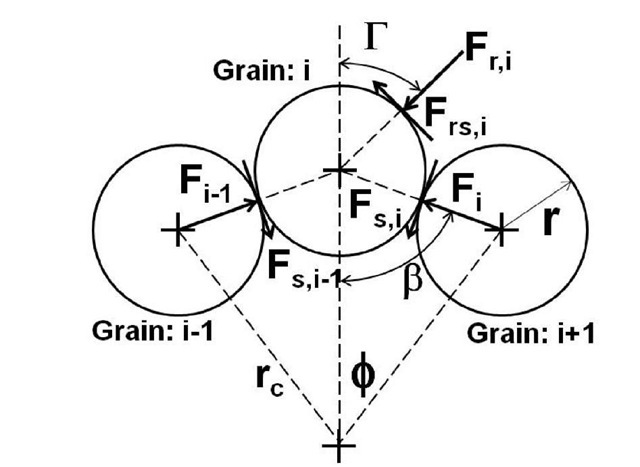
Figure 3 Communication chain inter-grain forces
FRICTIONLESS CASE
Inter-grain friction requires both that surface roughness and/or asperities exist and that these are activated by sufficient macroscopic deformation (resulting in relative grain-grain lateral sliding) and/or deformation at the grain contact (due to grain loading forces) [Cole 2008]. There are a number of materials and conditions which fail to satisfy these criteria and are represented reasonably by a frictionless model, e.g. as-poured smooth glass beads. Such contacts are dominated by normal contact forces and result in a conservative system of grains which lacks a dissipative mechanism. Ignoring all interfacial friction forces, it can be shown that the inter-grain forces are governed by:
If F0 is the applied force on the initial (i=0) grain then the force propagates as follows:
Plotting X as a function of non-dimensionalized r & rc shows that the forces increase along the chain for r < 0 and decrease for r > 0 (see Fig. 4). As noted previously this effect occurs due to the alignment of the confining force. The radius of curvature accentuates this effect for very small values (rc/r < 10). Small radii of curvature transition more of the chain load to the confining force instead of the adjacent grain; effectively branching the chain for very small radii of curvature.
Figure 4 X (ratio of forces for adjacent grains) plotted as function of r/Tmax & rc/r.
Plotting the number of grains required to decay the initial force (F0) to 5% of its initial value provides a more intuitive view of the same data. These values are capped at 300 grains both for practical readability reasons and because 300 grains easily span the container radii of interest (~40 – 100 mm for 0.4 mm diameter grains). As expected, r=0 is the dividing line between chains whose inter-grain forces decay and those that do not. The total chain length rapidly diminishes for r>0. This result helps explain how inter-grain forces in PM can be amplified locally (as noted by Peters 2005) by confining forces with r<0. The convergence of two chains is equivalent to r<0. Chains in materials with no friction have no theoretical length limit according to this analysis for r<0. Recall that this is a conservative system with no dissipative mechanism. As a result forces loads can be added to the chain by advantageous confining forces (r<0) or removed from the chain by chain branching (r>0 and small rc/r).
Figure 5 Number of grains required to decay inter-grain forces to 5% of initial load plotted as function of![]()
FRICTION AT CONFINING FORCE, NO INTER-GRAIN FRICTION
The previous model can be generalized slightly by including friction at the confining force interface (Frsi). This is a reasonable approximation for loosely-poured particles which do not experience enough macroscopic deformation to activate inter-grain friction (between grains in the chain), but for which small motion along the chain can activate friction at the radial constraint. The inter-grain force is again an exponential function of the number of grains as follows:
If F0 is the applied force on the initial (i=0) grain then the force propagates as follows:
A variety of friction coefficient values can be chose to represent various materials. Choosing |a=0.5 yields Figs. 6 & 7. Increasing the friction shifts the T=1 values. To maintain the force level in the chain, substantially negative r values are required to compensate for friction at the confining force. The system is no longer conservative and forces in the chain can degrade due to friction at the confining force interface (i.e. with grains adjacent to the chain).
Figure 6 X (ratio of forces for adjacent grains) plotted as function of![]()
The friction reduces the chain length for neutral r=0 values from ~ 300 grains to 75 or less. For 400 micron grains this cuts the chain length from 120mm to 30 mm and eliminates the ability of a single communication chain to communicate from projectile to container wall for containers smaller than ^ 75mm (for a ^ 15 mm projectile).
Figure 7 Number of grains required to decay inter-grain forces to 5% of initial load plotted as function of![]()
The friction coefficient at the confining force has a strong effect upon the chain length as summarized in the following figure. For these calculations r/rmax = 0.2. The longest chain lengths occur for the frictionless case and have roughly a parabolic dependence upon both the friction coefficient and the r/rmax ratio (near the X or T = 1plateau). The chain lengths have a nearly linear dependence upon the radius of curvature. 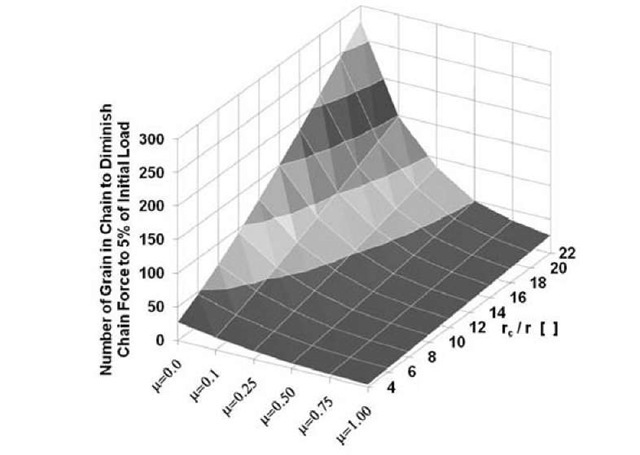
Figure 8 Chain length summary for various coefficient of friction values at the confining force
INTER-GRAIN FRICTION, NO FRICTION AT CONFINING FORCE
The multi-grain model shown in Fig. 3 is ill-posed if friction occurs at multiple interfaces. Additional information must be supplied to enable the system to properly utilize the friction coefficients. These coefficients are in fact maximum values which limit the frictional force up to (and potentially including) the onset of dynamic sliding. In practice the actual friction values might assume any value between zero and the limiting value. Simply choosing a single value for the inter-grain and confining force coefficients of friction results in highly non-intuitive and physically impossible scenarios.
However, there exists a very practical observation for chains with inter-grain friction (i.e. friction between particles in the communication chain). If the friction coefficient is sufficiently large (and grain rotation is assumed constrained) then no confining force is required. This is a reasonable approximation for mechanically-compacted particles where sufficient macroscopic deformation has occurred along the inter-grain interfaces, surface roughness exists, or grains deform enough (or some combination thereof) to activate inter-grain friction. Mechanical compaction forces grains into openings between adjacent grains, e.g. compaction may force the center grain in Fig. 3 down into the opening between the left & right-hand grains. If the inter-grain friction coefficient is large enough (assumed constant over the length of the chain for this analysis) then the center grain requires no confining force. The inter-grain frictional forces will constrain it. This action is responsible for both the residual normal & frictional forces between grains resulting from mechanical compaction; these forces produce a much stiffer particulate material skeleton and substantially increased shear strength.
Assuming the friction coefficient at all inter-grain interfaces is constant, there is no confining force, and the r/rc ratio is fixed along the chain length, it can be shown that the minimum inter-grain coefficient of friction is given by:
Plotting the geometric angle p and i^m as a function of the r/rc ratio (the inverse of the rjr ratio used previously—to simplify the figure) results in Fig 9. p is a linear function of r/rc and the minimum friction coefficient is nearly a linear function. As one might expect, when p=90° then the chain is straight and the minimum coefficient of friction is zero. As p decreases the chain becomes more curved and larger coefficients of friction are required. At the smallest curvature ratio, a minimum friction coefficient of nearly 0.6 is required to confine the grains in the chain without an external confining force.
This result helps explain the mechanical compactability of various particulate materials. For example, Eglin sand (used in previous experiments) has many surface artifacts which help activate friction between grains. Such sand mechanically compacts easily (roughly 10% by density) and produces a very stiff "crunchy" sand mass. Angles of repose greater than 90° are easily achieved and the sand must be mechanically sheared to enable subsequent flow. Compacted sand will not drain out of a bucket with a hole in the bottom. Clearly this sand has a coefficient of friction high enough to activate and utilize inter-grain friction to lock in normal and frictional stresses during mechanical compaction.
Glass beads, by contrast, are very smooth and difficult to mechanically compact. They retain little interfacial stresses and require little or no shearing to produce flow. Their coefficient of interfacial friction is so low that residual stresses can only be reatined in rather straight chains. Mechanically compacted glass beads can drain (with little or no stimulation) from a bucket with a hole in it.
Figure 9 Minimum inter-grain friction coefficient to eliminate confining force
It can be shown that if the minimum inter-grain friction coefficient is satisfied, the inter-grain forces do not decay along the length of the chain. Again, there is no mechanism for decay (no dissipative friction) and this system is again conservative. Thus, chains in a mechanically-compacted system could theoretically bridge long distances. The curvature of the chains would be limited by the inter-grain friction coefficients as noted in Eq. 9. Of course, distances are more easily bridged by straight chains and these are satisfied by the lowest coefficients of inter-grain friction. This could be a factor in the projectile impacts noted in the introduction.
Compacted sand in and around the crushed sand region would easily propagate stresses to the perimeter of the compacted region. If the particulate material were compacted prior to the experiment then this region could extend to the container wall. If the material was not pre-compacted then we might expect chains outside this compacted region as described by the "Friction at Confining Force" model.
SUMMARY
It was observed experimentally that projectile penetration depth is a function of container size when projectiles impact PM in cylindrical containers. Increasing the container size increases the penetration depth, suggesting a feedback mechanism between the container and projectile. Prior research suggests that the PM between the projectile and the container wall is composed of crushed PM (ahead of & adjacent to high-speed projectiles), compacted PM (either due to mechanical compaction prior to the experiment or due to dynamic compaction during the experiment), and as-poured PM. The highly-densified crushed PM is limited to a region within 1.5 projectile diameters of the shot line. Thus, some mechanism must be responsible for communicating stresses between the projectile (and crushed media) and larger containers.
It is proposed, in concurrence with previous researchers, that such stresses are communicated by stress chains. Previous stress chain definitions have been offered as a means to diagnose and understand the stress-carrying structure of the PM fabric. A further definition is therefore proposed to account for "communication chains" composed of multiple chain segments. Such communication chains are distinguished by the ability of the stress at one point or grain to influence the stress level at a remote point along the same communication chain.
Three analytical models are presented which indicate how stresses might be propagated along chains in frictionless PM, PM with friction at the confining forces, and PM with friction at inter-grain interfaces (i.e. between grains in the chain of interest). Each of these cases corresponds with a particular set of PMs. In the frictionless case the inter-grain force growth or decay is primarily influenced by the angle of the confining forces. For r<0 it is possible for the confining force to amplify forces in the chain. For chains with a fixed radius of curvature the force grows or decays exponentially with the number of grains. In the case with friction at the confining force, chain lengths can be cut by an order of magnitude (compared with the frictionless case) for the same r. The coefficient of friction and r strongly influence the chain length. In the case of inter- grain friction, it is shown that the chain radius of curvature suggests a minimum coefficient of friction which eliminates the need for a confining force to maintain the chain. When this coefficient of friction criteria is met then the force does not decay along the chain length.
In practice, each communication chains is likely to encounter a combination of these idealized conditions along their length, but this analysis helps decompose the problem and bound the limiting conditions for various PM types.
